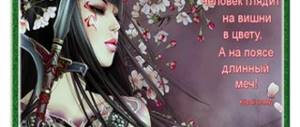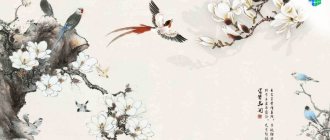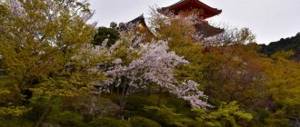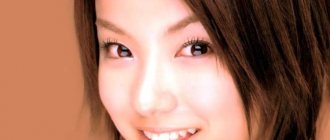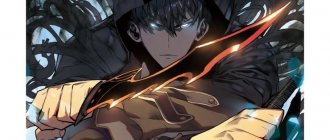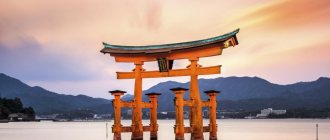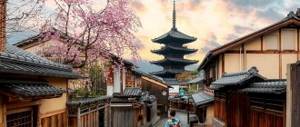Japan is a country with a very unique culture. Its formation was greatly facilitated by the peculiarities of the geographical location and geological factors. The Japanese were able to settle in the valleys and coasts, but they constantly suffer from typhoons, earthquakes, and tsunamis. Therefore, it is not surprising that their national consciousness deifies natural forces, and poetic thought strives to penetrate into the very essence of things. This desire is embodied in laconic forms of art.
Features of Japanese poetry
Before considering examples of haiku, it is necessary to pay attention to the features of the art of the Land of the Rising Sun. This brevity is expressed in different ways. It is also characteristic of the Japanese garden with its empty space, and origami, and works of painting and poetry. The main principles in the art of the Land of the Rising Sun are naturalness, understatement, and minimalism.
In Japanese, words don't rhyme. Therefore, the poetry familiar to the average person in our country could not emerge in this language. However, the Land of the Rising Sun gave the world no less beautiful works called haiku. They contain the wisdom of the eastern people, their unsurpassed ability to understand through natural phenomena the meaning of existence and the essence of man himself.
Just a little about waifu and syllabic phonography
In the Japanese language there are no consonants that act in our usual role as individual sounds. Instead of [k], a whole string of syllables is used: [ka], [ki], [ku], [ke] and [ko]. All other consonants are also joined by one of the five vowels [a], [i], [u], [e], [o] and in rare cases ['a], ['u], ['o] (soft variety - cf. Russian "mal" [small] - "crumpled" [m'al]). This recording system is called syllabic phonography.
It is precisely because of the syllabic phonetics of the Japanese language that Japanese first and last names always end in a vowel.
This phonetic feature of the Japanese language even affects borrowed words, and, for example, the English “fork” - fork - turns into foku, and wife and husband - into waifu and hazubando, familiar to modern lovers of Japanese culture. So you shouldn’t be surprised when on the English-language Internet, in the dialogue of otaku animation fans, you come across something like this: “A waifu with a naifu will end your laifu.”
Otaku is being threatened! Source
Haiku - the poetic art of the Land of the Rising Sun
The careful attitude of the Japanese towards their past, towards the heritage of antiquity, as well as strict adherence to the rules and norms of versification, turned haiku into a genuine art form. In Japan, haiku is a separate type of skill - for example, like the art of calligraphy. It acquired its true capacity at the end of the 17th century. The famous Japanese poet Matsuo Basho managed to raise it to an unsurpassed height.
The person portrayed in the poem is always against the backdrop of nature. Haiku is intended to convey and show phenomena, but not to name them directly. These short poems are sometimes called "pictures of nature" in the art of poetry. It is no coincidence that artistic canvases were also created for haiku.
Poetic one palm clap
As we see, haiku go back simultaneously to tanka pentaverses with their exquisite play on words, homonymy, sensual admiration of nature, and to humorous renga chains, in which the ability to preserve the theme set by the previous author was valued, while changing it in an unexpected way and creating a new artistic "refraction". But, in addition to the poetry of previous centuries, the formation of the genre was also influenced by religious philosophy, primarily Zen Buddhism. His followers (including those who were endowed with literary gifts) perceived the world in a special way.
Unlike the aristocrats who composed tanka, the haijin - the poet who writes haiku - did not use the surrounding reality as a mirror reflecting the subtle experiences and mental fluctuations of a person.
He lived “in the moment”: for him, a raven perched on a branch is a reason to contemplate the world and seek enlightenment in the ordinary. It is not surprising that many haiku are so similar to Zen koans.
The poem in the epigraph about an old pond into which a frog jumps, making a splash in the silence, subtly recalls the koan about the clap of one palm.
And here are the beautiful lines of Kaga no Chiyojo:
Tell me, butterfly, What did you see in your dream, flapping your wings?
Most likely, the poetess was referring to a well-known parable about the Chinese thinker, popular among Zen circles: “Once Zhuang Tzu dreamed that he was a butterfly, a cheerfully fluttering moth. He enjoyed it wholeheartedly and did not realize that he was Zhuang Tzu. But suddenly he woke up, was very surprised that he was Chuang Tzu, and could not understand: did Chuang Tzu dream that he was a butterfly, or did the butterfly dream that she was Chuang Tzu?!
Song Chuang Tzu. Source
Size
Many readers wonder how to write haiku. Examples of these poems show: haiku is a short work that consists of only three lines. In this case, the first line should contain five syllables, the second – seven, the third – also five. For centuries, haiku has been the primary poetic form. Brevity, semantic capacity and mandatory appeal to nature are the main characteristics of this genre. In reality, there are many more rules for adding haiku. It’s hard to believe, but in Japan the art of composing such miniatures has been taught for decades. And painting lessons were also added to these activities.
The Japanese also understand haiku as a work consisting of three phrases of 5, 7, 5 syllables. The difference in the perception of these poems by different peoples is that in other languages they are usually written in three lines. In Japanese they are written on one line. And before they could be seen written from top to bottom.
How to Read and Understand Haiku
Translator from Japanese - about three-line haiku poetry, its history, translations and why it is beautiful
Author Elena Dyakonova
Matsuo Basho. Engraving by Tsukioka Yoshitoshi from the series “101 Views of the Moon.” 1891 © The Library of Congress
The haiku genre is derived from another classical genre, the 31-syllable tanka pentaverse, known since the 8th century. There was a caesura in the tanka, at this point it “broke” into two parts, resulting in a tercet of 17 syllables and a couplet of 14 syllables - a kind of dialogue, which was often composed by two authors. This original tercet was called haiku, which literally means “initial stanzas.” Then, when the tercet received its own meaning and became a genre with its own complex laws, it began to be called haiku.
The Japanese genius finds himself in brevity. The haiku tercet is the most laconic genre of Japanese poetry: only 17 syllables of 5–7–5 mor Mora is a unit of measurement of the number (longitude) of a foot. Mora is the time required to pronounce a short syllable. in line. There are only three or four significant words in a 17-syllable poem. In Japanese, a haiku is written in one line from top to bottom. In European languages, haiku is written in three lines. Japanese poetry does not know rhymes; by the 9th century, the phonetics of the Japanese language had developed, including only 5 vowels (a, i, u, e, o) and 10 consonants (except for voiced ones). With such phonetic poverty, no interesting rhyme is possible. Formally, the poem is based on the count of syllables.
Until the 17th century, haiku writing was viewed as a game. Haiku became a serious genre with the appearance of the poet Matsuo Basho on the literary scene. In 1681, he wrote the famous poem about the crow and completely changed the world of haiku:
A raven turns black on a dead branch. Autumn evening. Translation by Konstantin Balmont.
Let us note that the Russian symbolist of the older generation, Konstantin Balmont, in this translation replaced the “dry” branch with a “dead” one, excessively, according to the laws of Japanese versification, dramatizing this poem. The translation turns out to violate the rule of avoiding evaluative words and definitions in general, except for the most ordinary ones. “Words of haiku” (haigo) should be distinguished by deliberate, precisely calibrated simplicity, difficult to achieve, but clearly felt blandness. Nevertheless, this translation correctly conveys the atmosphere created by Basho in this haiku, which has become a classic, the melancholy of loneliness, the universal sadness.
There is another translation of this poem:
A raven sits alone on a bare branch... Autumn evening! Here and below are translations by Vera Markova.
Here the translator added the word “lonely,” which is not in the Japanese text, but its inclusion is nevertheless justified, since “sad loneliness on an autumn evening” is the main theme of this haiku. Both translations are rated very highly by critics.
However, it is obvious that the poem is even simpler than the translators presented. If you give its literal translation and place it in one line, as the Japanese write haiku, you will get the following extremely short statement:
枯れ枝にからすのとまりけるや秋の暮れ
On a dry branch / a raven sits / autumn twilight
As we can see, the word “black” is missing in the original, it is only implied. The image of a “chilled raven on a bare tree” is Chinese in origin. “Autumn twilight” (aki no kure) can be interpreted as both “late autumn” and “autumn evening”. Monochrome is a quality highly valued in the art of haiku; depicts the time of day and year, erasing all colors.
Haiku is least of all a description. It is necessary not to describe, the classics said, but to name things (literally “to give names to things” - nora) in extremely simple words and as if you are naming them for the first time.
Raven on a winter branch. Engraving by Watanabe Seitei. Around 1900 © ukiyo-e.org
Haiku are not miniatures, as they were long called in Europe. The greatest haiku poet of the late 19th - early 20th centuries, who died early from tuberculosis, Masaoka Shiki, wrote that haiku contains the whole world: the raging ocean, earthquakes, typhoons, the sky and stars - the whole earth with the highest peaks and the deepest sea depressions. The space of haiku is immense, infinite. In addition, haiku tends to be combined into cycles, into poetic diaries - and often life-long, so that the brevity of haiku can turn into its opposite: into long works - collections of poems (though of a discrete, intermittent nature).
But the passage of time, the past and the future are not depicted by haiku; haiku is a short moment of the present - and nothing more. Here is an example of a haiku by Issa, perhaps the most beloved poet in Japan:
How the cherry blossomed! She drove the proud prince off his horse.
Transience is an immanent property of life in the Japanese understanding; without it, life has no value or meaning. Fleetingness is both beautiful and sad because its nature is fickle and changeable.
Haiku should not be considered landscape poetry. The Japanese themselves have never written about haiku in this spirit, although they admit that the main theme of haiku is “the poet and his landscape.”
An important place in haiku poetry is the connection with the four seasons - autumn, winter, spring and summer. The sages said: “He who has seen the seasons has seen everything.” That is, I saw birth, growing up, love, rebirth and death. Therefore, in classical haiku, a necessary element is the “seasonal word” (kigo), which connects the poem to the season. Sometimes these words are difficult for foreigners to recognize, but the Japanese know them all. Detailed kigo databases, some of thousands of words, are now being searched on Japanese networks.
In the above haiku about the crow, the seasonal word is very simple - "autumn." The coloring of this poem is very dark, emphasized by the atmosphere of an autumn evening, literally “autumn twilight,” that is, black against the background of deepening twilight.
Look how gracefully Basho introduces the essential sign of the season into a poem about separation:
I grabbed a spike of barley, looking for support... How difficult is the moment of separation!
“A spike of barley” directly indicates the end of summer.
Or in the tragic poem of the poetess Chiyo-ni on the death of her little son:
O my dragonfly catcher! Where in the unknown country have you run to today?
"Dragonfly" is a seasonal word for summer.
Another “summer” poem by Basho:
Summer herbs! Here they are, fallen warriors Dreams of glory...
Basho is called the poet of wanderings: he wandered a lot around Japan in search of true haiku, and, when setting off, he did not care about food, lodging, tramps, or the vicissitudes of the path in the remote mountains. On the way, he was accompanied by the fear of death. A sign of this fear was the image of “Bones Whitening in the Field” - this was the title of the first book of his poetic diary, written in the genre of haibun (“prose in the style of haiku”):
Maybe the wind will whiten my bones... It breathed coldness into my heart.
After Basho, the theme of “death on the way” became canonical. Here is his last poem, “The Dying Song”:
On the way I fell ill, And my dream keeps running and circling through the scorched fields.
Imitating Basho, haiku poets always composed “last stanzas” before they died.
The “true” (makoto-no) poems of Basho, Buson, and Issa are close to our contemporaries. The historical distance is, as it were, removed in them due to the immutability of the haiku language, its formulaic nature, which has been preserved throughout the history of the genre from the 15th century to the present day.
The main thing in the worldview of a haikaist is an acute personal interest in the form of things, their essence, and connections. Let us remember the words of Basho: “Learn from the pine tree what pine is, learn from bamboo what bamboo is.” Japanese poets cultivated meditative contemplation of nature, peering into the objects surrounding a person in the world, into the endless cycle of things in nature, into its bodily, sensual features. The poet's goal is to observe nature and intuitively discern its connections with the human world; haikaists rejected ugliness, pointlessness, utilitarianism, and abstraction.
Basho created not only haiku poetry and haibun prose, but also the image of a poet-wanderer - a noble man, outwardly ascetic, in a poor dress, far from everything worldly, but also aware of the sad involvement in everything happening in the world, preaching conscious “simplification”. The haiku poet is characterized by an obsession with wandering, the Zen Buddhist ability to embody the great in the small, awareness of the frailty of the world, the fragility and variability of life, the loneliness of man in the universe, the tart bitterness of existence, a sense of the inseparability of nature and man, hypersensitivity to all natural phenomena and the change of seasons.
The ideal of such a person is poverty, simplicity, sincerity, a state of spiritual concentration necessary to comprehend things, but also lightness, transparency of verse, the ability to depict the eternal in the current.
At the end of these notes, we present two poems by Issa, a poet who treated with tenderness everything small, fragile, and defenseless:
Quietly, quietly crawl, Snail, along the slope of Fuji, Up to the very heights!
Hiding under the bridge, Sleeping on a snowy winter night, a homeless child.
Haiku poems: examples for children
Often schoolchildren receive homework assignments to learn or compose haiku. These short poems are easy to read and quick to remember. This is demonstrated by the following example of haiku (2nd grade is too early to cover Japanese poetry, but students can refer to this tercet if necessary):
The sun sets, And the cobwebs also melt in the darkness...
The author of this laconic poem is Basho. Despite the capacity of the tercet, the reader must use his imagination and partially participate in the creative work of the Japanese poet. The following haiku is also written by Basho. In it, the poet depicts the carefree life of a little bird:
In the free meadows the lark bursts into song without labor or worries...
I'll wait for you by the pine tree
From the earliest times, Japanese poets willingly used homonymy in their works, both jokingly and seriously. Thus, matsu can be the verb "to wait" and the noun "pine", and word play based on such phonetic coincidence is often found in classical poetry. When mentioning this tree in their poems, their authors almost always introduced the theme of waiting for a meeting into the work. Here is a short song from the oldest poetic anthology “Man'yoshu” (VII-VIII centuries) translated by Anna Gluskina, which uses this technique:
Without taking your eyes off the green pine
, What grows near my house, I will
wait
for you, Come back to me soon, Oh, before I die of melancholy!
The Japanese poetess used the word matsu once, but in both mentioned meanings at the same time, and the Russian translator needed two lines to convey the meaning contained in it.
In a very similar song from the same collection, a girl is reminded of her lover by a pine tree, which they traditionally planted together:
Oh, if you had not come here, it would still be a green pine
The one who was planted together with you, so that she could serve as a memory for us,
wait for
, my dear.
Kigo
Many readers are wondering how to write haiku in Russian. Examples of these tercets show that one of the main features of this genre of poetry is the correlation of a person’s internal state with the time of year. This rule can also be used when composing your own haiku. The rules of classical versification required the use of a special “seasonal” word - kigo. It is a word or phrase that indicates the season described in the poem.
For example, the word "snow" would indicate winter. The phrase “Hazy moon” may indicate the onset of spring. Mention of sakura (Japanese cherry tree) will also indicate spring. The word kinge - “goldfish” - will indicate that the poet depicts summer in his poem. This custom of using kigo came into the haiku genre from other forms. However, these words also help the poet choose laconic words and give the meaning of the work even greater depth.
The following haiku example will tell about summer:
The sun is shining. The birds became quiet at noon. Summer has come.
And after reading the following Japanese tercet, you can understand that the season being described is spring:
Cherry blossoms. Dali was shrouded in fog. Dawn has arrived.
Deviation from the generally accepted norm
There are always artists or poets who strive to break generally accepted, classical rules. The same goes for writing haiku. If the standard for writing these tercets presupposes a 5-7-5 structure, the use of “cutting” and “seasonal” words, then at all times there have been innovators who in their creativity sought to ignore these instructions. There is an opinion that haiku, which do not have a seasonal word, should be classified as senryu - humorous tercets. However, such a categorization does not take into account the existence of flour - haiku, in which there is no indication of the season, and which simply does not need it to reveal its meaning.
Look for the secret. Unfinished bridge
When two understandable images are juxtaposed or contrasted in a haiku, everything is clear, a bridge is built and allows us to move from one visible space to another. But there are haiku in which only one shore is visible - the one from which everything begins, on which one end of the bridge stands. The other is lost in the mysterious haze of what is unspoken in the verse. We can only feel the depth and alluring beauty of existence through the skillfully created interlines of the haiku, but we cannot decompose into its components the elusive aroma hovering around such a verse, we can only inhale it... We must listen very carefully, gently and deeply, almost meditatively, to the world , nature, your soul, and then, perhaps, it will be revealed to the beholder...
The surf is crashing. girl with a phone looking at the water Gleb Secreta
Haiku without a seasonal word
Let's look at an example of haiku that can be classified in this group:
A cat is walking along a city street, the windows are open.
Here, the indication of what time of year the animal left home is not important - the reader can observe the picture of the cat leaving home, completing the complete picture in his imagination. Perhaps something happened at home that the owners did not pay attention to the open window, and the cat slipped through it and went for a long walk. Maybe the owner of the house is anxiously waiting for her four-legged pet to return. In this haiku example, it is not necessary to indicate the season to describe feelings.
About the tank
Tanka , at its core, is a short song, the trendsetter of the Japanese poetic genre. According to tradition, tanka comes from folk ritual and calendar poetry. Thangka shifted long verses called nagauta . The most common theme of medieval Japanese poetry was the seasons. The tanka also reflected all 4 seasons. Often, people’s economic affairs were closely connected with the seasons. Hence another theme - everyday life and the simple life of people. The peculiarity of the tank was the fleeting nature of the mood; they are full of understatements and verbal play. You need to read the tanka with a melody in your voice, slowly and with feeling.
Is there always a hidden meaning in Japanese tercets?
Looking at various examples of haiku, one can see the simplicity of these tercets. Many of them lack hidden meaning. They describe ordinary natural phenomena perceived by the poet. The following example of haiku in Russian, authored by the famous Japanese poet Matsuo Basho, describes a picture of nature:
A raven turns black on a dead branch. Autumn evening.
This is how haiku differs from the Western poetic tradition. Many of them have no hidden meaning, but reflect the true principles of Zen Buddhism. In the West, it is customary to fill every thing with hidden symbolism. This meaning is not found in the following example of nature haiku, also written by Basho:
I'm walking along the path up the mountain. ABOUT! How wonderful! Violet!
Writing Japanese Poems Correctly: Basic Principles of Haiku
- Writing haiku is quite different from writing classical rhyming poetry. To write poetry in the Japanese style, you need to learn to use a minimum number of words, but filled with the necessary meaning, and cut off all that is unnecessary. It is important to avoid repetitions, tautologies and cognates, if possible. Being able to say a lot through a little is the main principle of writing Japanese tercets.
- Learn to convey meaning without describing it literally. The author has the right to understatement: his task is to evoke certain feelings and sensations in readers, and not to chew them in detail. Readers need to figure out and understand the author’s content on their own. But at the same time, this content should be easily understandable; the reader should not sit for hours and solve a single tercet.
First summer rain. I open and... fold the umbrella. Felix Tammy
- Japanese haiku do not tolerate pathos and artificiality. The art of composing tercets is based on sincerity, so do not compose something that cannot actually happen. Such Japanese poetry should be understandable to everyone, so do not use slang words and expressions when writing.
- Haiku should only be written in the present tense form, since these Japanese poems depict only those events that have just happened and were seen, heard or felt by the author.
- Japanese poetry is richer in homonyms than Russian, but when writing Russian tercets, you should not miss the opportunity to use wordplay.
The ferry leaves, the soul is torn in the wind... Goodbye and don't cry. O'Sanchez
- A technique that Japanese poets often use is a comparison of various phenomena and objects. The main condition is the use of comparisons that happen naturally and that do not need to be supported by comparative words and conjunctions “as if,” “like,” etc.
All the paths are covered with snow... the neighbor goes out into the yard with his own path. Taisha
We hope that our tips will help you master the art of composing haiku. And now we invite you to learn from the best and watch the following video, which examines Japanese poetry, in particular, such famous Japanese poets as Matsuo Basho, Kobayashi Issa, Yesa Buson and many others.
General and specific in haiku
It is known that the Japanese people have a cult of nature. In the Land of the Rising Sun, the surrounding world is treated in a completely special way - for its inhabitants, nature is a separate spiritual world. In haiku, the motive of the universal connection of things is manifested. Specific things that are described in tercets are always connected with the general cycle; they become part of a series of endless changes. Even the four seasons of the year are divided by Japanese poets into shorter subseasons.
The first drop from the sky fell on my hand. Autumn is approaching.
Writing Tips
James Hackett, who was one of the most influential Western writers of haiku, believed that these tercets convey sensations “as they are.” And this is precisely what is characteristic of Basho’s poetry, which shows the immediacy of the current moment. Hackett gives the following tips to help you write your own haiku:
- The source of the poem must be life itself. They can and should describe daily events that at first glance seem ordinary.
- When composing haiku, one should contemplate nature in the immediate vicinity.
- It is necessary to identify yourself with what is described in the tercet.
- It is always better to think alone.
- It's better to use simple language.
- It is advisable to mention the time of year.
- Haiku should be simple and clear.
Hackett also said that anyone who wants to create beautiful haiku should remember the words of Basho: “Haiku is the finger that points to the moon.” If this finger is decorated with rings, then the attention of the audience will be focused on these jewelry, and not on the heavenly body. The finger does not need any decoration. In other words, various rhymes, metaphors, similes and other literary devices are unnecessary in haiku.
A quick summary of what not to do when writing haiku
- Don’t write in rhyme, it gives a feeling of completion, but in a haiku the door of understatement should remain slightly open and inviting.
- Do not write in a didactic, pompous or sententious manner, and do not make judgments.
- Do not invent haiku “out of your head”, do not operate with the insubstantial, abstract, but make the subject of the haiku the world around you and your own experience, even imaginary.
- Don't try to name the feeling or state, just show it.
- Do not write aphorisms, imposing the only idea that arose in you.
- Don't write about times other than the present, or write through the lens of the present—the haiku should make it feel like events are unfolding before your eyes.
- Try to avoid obvious metaphors, comparisons, personifications, etc. A metaphor is acceptable if both its metaphorical and literal reading are equally possible.
- Technique for the sake of technique makes the haiku flat and deprives it of spontaneity. Wordplay, graphic tricks, etc. are good only if they are semantically adequacy - as in any literary text.
the gate slammed, the petals of the chamomile are closed at night, Ethel Yanova doesn’t take this tram to the park Belka, by old age there are so many convolutions in the brain... I’ve lost my thought! Wanja-san
